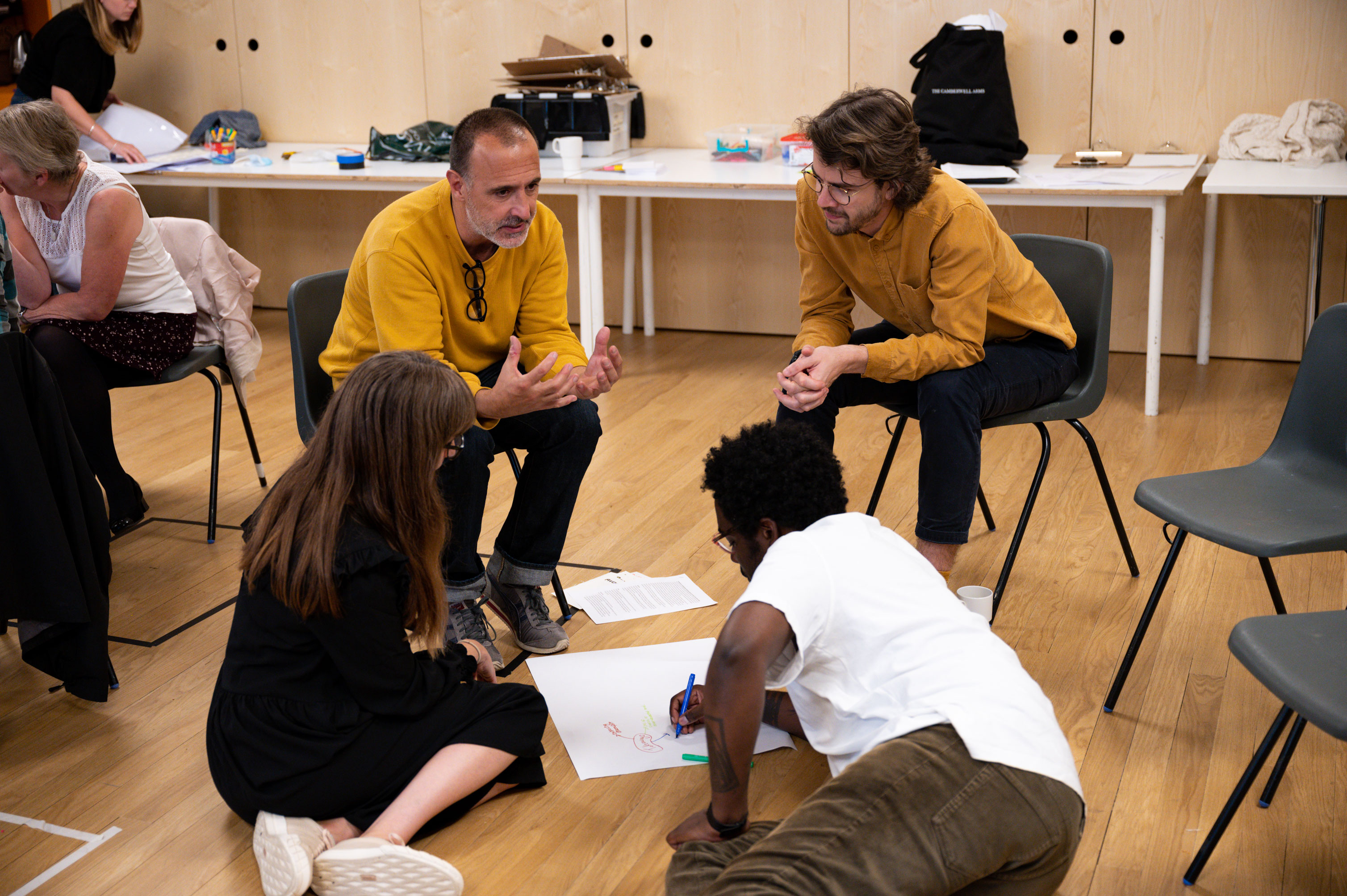Group Reflective: Unlocking The Power Of Team Growth
Hey there, if you're diving into the world of team development and collaboration, "group reflective" is a term you need to get familiar with. It’s not just some fancy buzzword; it’s a powerful process that can transform how teams learn, grow, and succeed. Think of it as the secret sauce that helps teams analyze their performance and identify areas for improvement. So, let's dig in and explore why this concept matters so much and how it can make a difference for your team.
When we talk about group reflective, we're referring to the practice where teams take a step back and evaluate their collective experiences. It's like a mirror that reflects both the strengths and weaknesses of the group. This process helps teams understand what they've done well and where they can improve. Sounds pretty straightforward, right? But trust me, there's a lot more to it than meets the eye.
Now, before we dive deeper, let me ask you a question: Have you ever been part of a team where things seemed to be going well, but then suddenly, communication broke down, and everything went south? If you’ve ever been in that situation, you know how important it is to have mechanisms in place to prevent those kinds of meltdowns. That's where group reflective comes into play. It helps teams stay on track and ensures continuous growth.
Read also:Oceans 8 Billiards Photos The Ultimate Guide To Style Glamour And Pool Table Magic
What is Group Reflective?
Alright, let's break it down. Group reflective is basically the process where a team comes together to assess their performance, goals, and challenges. It’s not just about pointing fingers or assigning blame; it’s about fostering an environment where everyone feels comfortable sharing their thoughts and ideas. The goal is simple: learn from the past and build a better future.
Here’s the deal: when teams engage in reflective practices, they gain insights that they might not have noticed otherwise. It’s like putting on a pair of glasses that help you see things more clearly. And let’s be honest, who doesn’t want clearer vision when it comes to teamwork?
Some key aspects of group reflective include open communication, active listening, and a willingness to embrace feedback. These elements create a culture of trust and collaboration, which is essential for any team that wants to thrive.
Why Group Reflective Matters
So, why should you care about group reflective? Well, here’s the thing: teams that don’t reflect on their experiences are like ships without a compass. They may be moving forward, but they have no idea if they’re heading in the right direction. Group reflective helps teams stay focused and aligned with their goals.
It also promotes accountability. When team members are encouraged to reflect on their actions and contributions, they become more aware of their roles and responsibilities. This awareness leads to better performance and a stronger sense of ownership over the team’s success.
Another reason why group reflective matters is that it fosters innovation. When teams take the time to reflect, they often come up with creative solutions to problems they may not have even realized existed. It’s like unlocking hidden potential that was there all along but just needed a little nudge to surface.
Read also:Unveiling The Fascinating World Of Andy Suz A Deep Dive Into His Life Career And Achievements
Key Benefits of Group Reflective
Let’s talk about some of the amazing benefits that come with practicing group reflective. First and foremost, it enhances communication. When team members feel comfortable sharing their thoughts and feedback, it creates an open dialogue that strengthens relationships and builds trust.
Another benefit is improved problem-solving. By reflecting on past experiences, teams can identify patterns and trends that may have contributed to certain outcomes. This knowledge allows them to approach future challenges with a more strategic mindset.
And let’s not forget about personal growth. Group reflective isn’t just about improving the team as a whole; it also helps individuals grow and develop. When team members reflect on their own contributions, they gain valuable insights that can help them become better versions of themselves.
How Group Reflective Boosts Team Performance
Okay, so we’ve talked about the benefits, but how exactly does group reflective boost team performance? It all comes down to one simple idea: learning from experience. When teams take the time to reflect, they gain a deeper understanding of what works and what doesn’t. This knowledge empowers them to make informed decisions and take action that leads to better results.
For example, imagine a marketing team that just launched a new campaign. After the campaign wraps up, the team sits down to reflect on what went well and what could have been done better. They discover that their social media strategy was a huge success, but their email marketing efforts fell flat. Armed with this information, they can adjust their approach for the next campaign and achieve even better results.
How to Implement Group Reflective
Now that you know why group reflective is important, let’s talk about how to implement it in your team. The first step is to create a safe and supportive environment where team members feel comfortable sharing their thoughts. This means setting ground rules for respectful communication and ensuring that everyone’s voice is heard.
Next, establish a regular schedule for reflective sessions. Whether it’s weekly, monthly, or quarterly, consistency is key. These sessions should be viewed as an opportunity for growth, not as a chore or obligation.
Finally, encourage active participation. This means not only allowing team members to share their thoughts but also actively seeking out their input. Ask open-ended questions, listen attentively, and provide constructive feedback.
Tools and Techniques for Group Reflective
There are plenty of tools and techniques you can use to facilitate group reflective. One popular method is the "after-action review," which is commonly used in military and business settings. This technique involves reviewing a specific event or project and discussing what went well, what didn’t, and how things can be improved in the future.
Another effective tool is the "stop, start, continue" framework. This simple yet powerful method encourages teams to identify actions they should stop doing, actions they should start doing, and actions they should continue doing. It’s a great way to focus on actionable insights and drive meaningful change.
And let’s not forget about visual aids like mind maps and flowcharts. These tools can help teams organize their thoughts and ideas in a way that’s easy to understand and act upon.
Common Challenges in Group Reflective
Of course, no process is without its challenges, and group reflective is no exception. One common issue is resistance to change. Some team members may be hesitant to embrace reflective practices, especially if they’re used to a more traditional approach. To overcome this, it’s important to communicate the benefits and provide training and support as needed.
Another challenge is ensuring that everyone’s voice is heard. In some cases, dominant personalities may overshadow quieter team members, which can lead to an imbalanced reflection. To prevent this, consider using techniques like round-robin discussions or anonymous feedback forms.
Finally, there’s the issue of time constraints. Reflective sessions can be time-consuming, especially if they’re not well-structured. To address this, set clear agendas and time limits for each session, and make sure everyone is prepared to participate fully.
Overcoming Resistance to Group Reflective
Let’s dive a little deeper into how you can overcome resistance to group reflective. One effective strategy is to lead by example. If team leaders and managers actively participate in reflective practices, it sets a positive tone and encourages others to follow suit.
Another approach is to tie reflective practices to tangible outcomes. For instance, if a team reflects on a recent project and identifies ways to improve efficiency, they can implement those changes and measure the results. Seeing the impact of their efforts can be a powerful motivator for continued participation.
And don’t forget about celebrating successes. When teams achieve positive results through reflective practices, take the time to acknowledge and celebrate those achievements. It reinforces the value of the process and keeps everyone motivated to continue.
Best Practices for Group Reflective
Now that we’ve covered the basics, let’s talk about some best practices for group reflective. First and foremost, keep it simple. Overcomplicating the process can lead to confusion and frustration, so stick to straightforward methods that are easy to implement.
Secondly, focus on action. Reflection is great, but it only becomes valuable when it leads to tangible changes. Encourage teams to identify specific actions they can take based on their reflections and track their progress over time.
Finally, make it a habit. Like any skill, reflective practices improve with practice. The more teams engage in reflection, the better they’ll become at identifying opportunities for growth and improvement.
Measuring the Impact of Group Reflective
So, how do you measure the impact of group reflective? There are several metrics you can use to gauge its effectiveness. One approach is to track key performance indicators (KPIs) related to team performance, such as productivity, communication, and collaboration.
Another method is to gather feedback from team members themselves. Conduct surveys or interviews to get their thoughts on how reflective practices have impacted their work and their relationships with colleagues.
And let’s not forget about qualitative data. Sometimes the most valuable insights come from observing changes in team dynamics and attitudes. Pay attention to shifts in behavior and communication patterns, as these can be powerful indicators of growth and improvement.
Real-World Examples of Group Reflective
Let’s look at some real-world examples of how group reflective has been successfully implemented. One company that stands out is Google. They’re known for their innovative approach to team development, and group reflective plays a big role in that. By encouraging teams to regularly assess their performance and share feedback, Google has been able to maintain its position as a leader in the tech industry.
Another example comes from the healthcare sector. A hospital in the UK implemented group reflective practices to improve patient care. By regularly reviewing patient outcomes and discussing areas for improvement, the hospital was able to reduce readmission rates and improve overall satisfaction scores.
And in the world of education, many schools have adopted reflective practices to enhance student learning. By encouraging teachers to reflect on their teaching methods and collaborate with colleagues, these schools have seen improvements in student performance and engagement.
Conclusion: Embrace the Power of Group Reflective
As we wrap up, let’s recap the key points we’ve covered. Group reflective is a powerful tool for team growth and development. It promotes open communication, fosters innovation, and enhances problem-solving skills. By implementing reflective practices in your team, you can unlock hidden potential and achieve better results.
So, what’s the next step? Start small. Begin by introducing reflective sessions and gradually build them into your team’s routine. Encourage participation, celebrate successes, and most importantly, keep learning. Remember, the journey of growth never truly ends.
And hey, don’t forget to share this article with your friends and colleagues. The more people who understand the power of group reflective, the better off we all are. So, go ahead and spread the word. Your team will thank you for it!
Table of Contents
- What is Group Reflective?
- Why Group Reflective Matters
- Key Benefits of Group Reflective
- How Group Reflective Boosts Team Performance
- How to Implement Group Reflective
- Tools and Techniques for Group Reflective
- Common Challenges in Group Reflective
- Best Practices for Group Reflective
- Real-World Examples of Group Reflective
- Conclusion: Embrace the Power of Group Reflective


